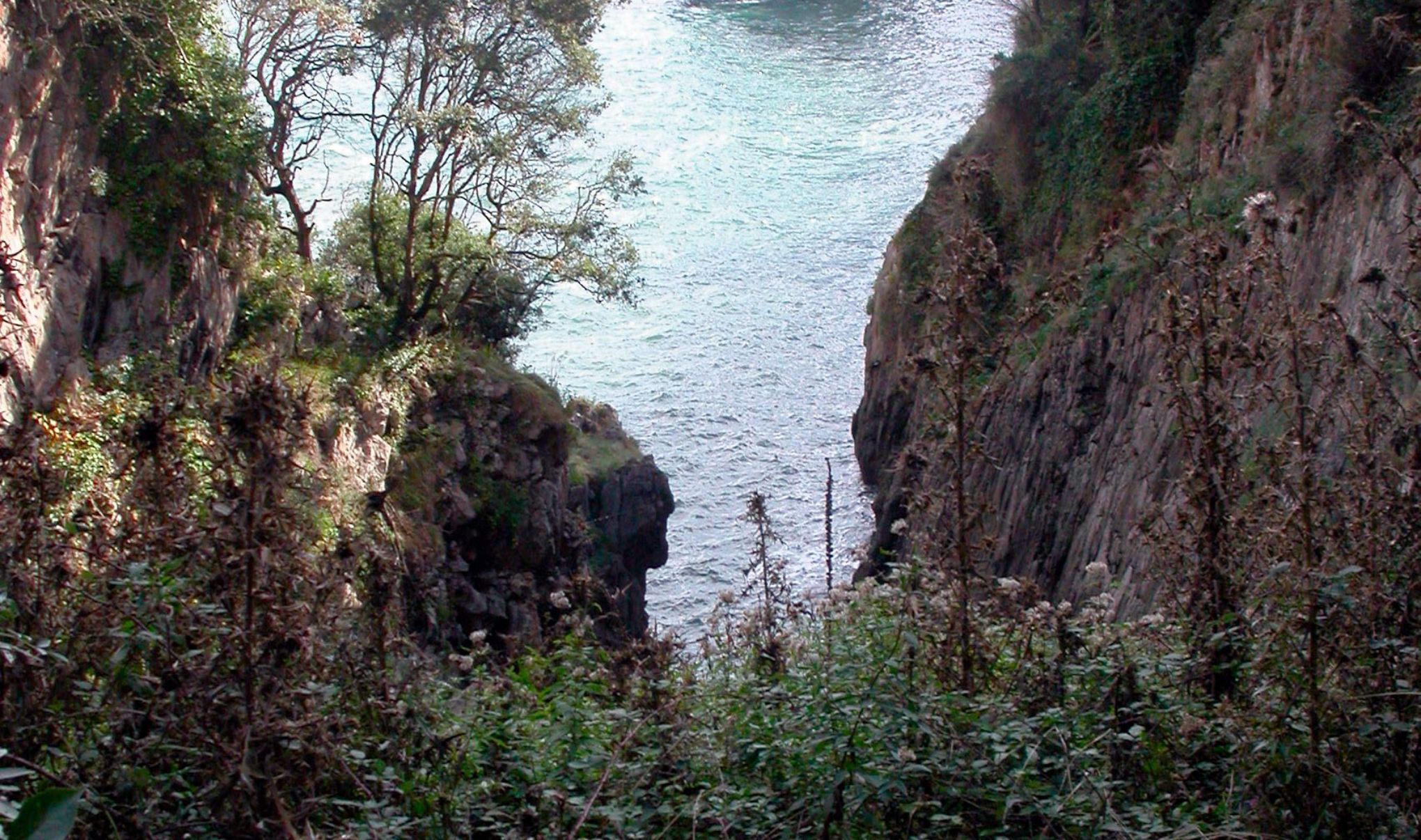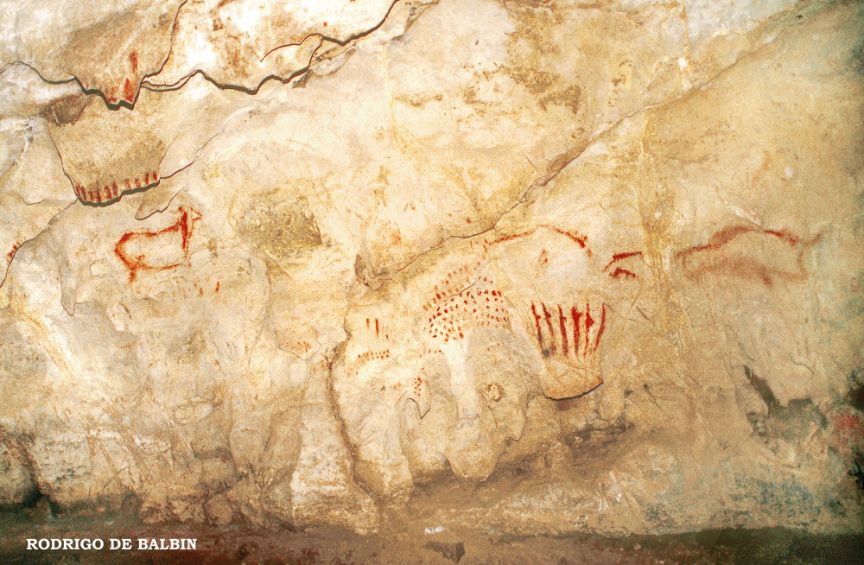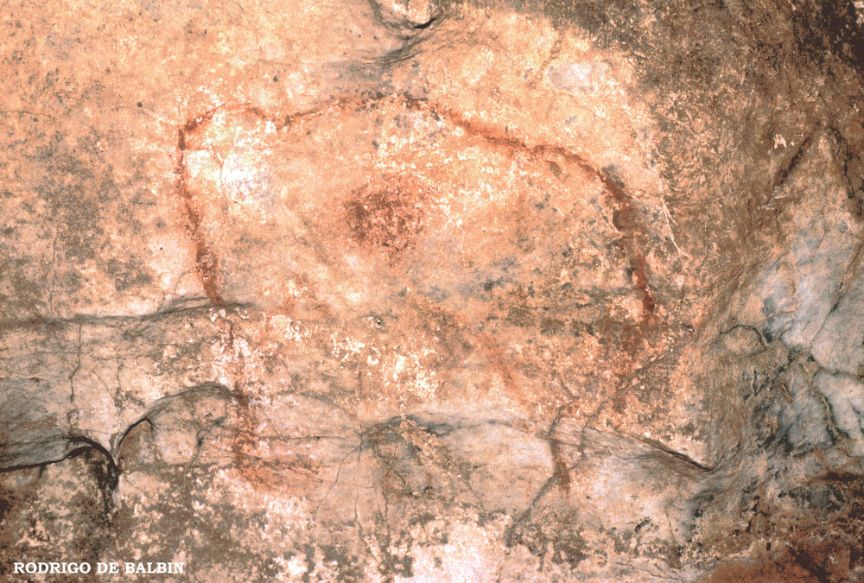El Pindal Cave

Identification of the Property
SubirPimiango, Ribadedeva, Principality of Asturias.
Access
Turn off the N-634 at El Peral and take the RD-1 to Pimiango. A local road goes to the sanctuary of Santu Medé. From here, take a path down to the cave entrance.
Geographical coordinates
UTM 30T 375980E / 4806305N Z: 20
Description
SubirTopographic description
El Pindal cave, located at the eastern end of Asturias, opens out, overlooking the Bay of Biscay, on the cliffs next to San Emeterio Headland. This coastal scenery is, as in the case of Tito Bustillo Cave, quite different from what the Palaeolithic occupants of the cave would have seen, as the coast-line would have been several kilometres further north as a result of the marine regression that took place in the last glacial period.
 Pulse para ampliar
Pulse para ampliar
Relatively simple in form, the cave consists of a long and straight passage, running west-east, with a total length of 475m. It is usually described as having two sectors. To the west, the hidden sector consists of a narrow passage that leads to two successive chambers, choked by collapsed boulders; to the east, the large passage (open to the public) has a small stream that flows in wet seasons. The cave’s morphology is a response to structural factors, such as fractures and bedding planes in the limestone that have determined the form of the walls and roof of the passage, the dip or inclination to the east and the folding between the hidden and public sectors. Geomorphological factors have acted upon these, especially the erosive processes of the stream, which has captured three other streams advancing successively towards the west; the water draining from the dolines of Santu Medé, La Llongar and La Tronía. In this way, the two sectors of the cave have been united in a single passage.
Date of Discovery
The archaeological interest of El Pindal Cave was discovered in April 1908 by H. Alcalde del Río, one of the pioneers of prehistoric research in the region. It thus became the first cave with Palaeolithic art to be known in Asturias.
Archaeological research
Alcalde del Río himself made the first study of the cave, which formed part of the first major synthetic work on Palaeolithic cave art in Northern Spain, published by Alcalde together with H. Breuil and L. Sierra in 1911. In later years, other relevant archaeologists working on the Prehistory of Asturias have documented the artistic contents of the site, such as J. Fernández Menéndez in the 1920s and F. Jordá Cerdá and M. Berenguer in the 1950s. The latest contributions to the understanding of the art ensemble have been made by R. Balbín Behrmann and J. Fortea Peréz.
Artistic contents: paintings and engravings
The normal route for visiting the cave goes from east to west, in the opposite direction to the natural development of the cave. Thus, prehistorians have usually described the different groups of art from the start of the cave to the end, separating the groups on the left or southern wall from those on the right or northern wall. The latter is more suitable for art, as the surfaces are relatively large, smooth, clean and vertical, in contrast with the left hand wall where the inclined and cracked surfaces would be more difficult to decorate. The art can be divided into five groups. The first is 120m from the entrance, on the left wall. 37 A larger group is found 240m from the entrance on the right wall. This is 20m long and contains the majority of figures known in the cave. A few metres further on, another two decorated surfaces lie very near to each other. The deepest art in the cave is located 300m from the entrance, in a small chamber above the main passage.
Almost 30 animal figures are known in the cave (13 bison, 8 horses, 3 deer, 2 mammoths, other indeterminate quadrupeds and a fish can be recognised). There are also a considerable number of signs, all of them painted in red, among which the claviforms or mace-shaped signs are especially significant. Dots, vertical lines, loops, branching-shapes and closed signs are also found, among others. The total number of depictions is about fifty, although there is no “definitive”, scientifically accepted inventory.
 Pulse para ampliar
Pulse para ampliar
The chronological assessment of the art at El Pindal is complex, and since the original discovery some very different proposals have been put forward. The first students of the cave, particularly H. Breuil, favoured a long chronology and divided the art into four groups by combining criteria of the techniques used and the style of the figures. In this way, they distinguished an archaic group of red paintings, a second group of red dotted paintings, a group of black paintings and a final group of painted and engraved depictions with polychromic touches. Thus, chronologies were assigned to each group, going from the Aurignacian (about 35,000 B.P.) to the Magdalenian (16,000-10,000 B.P.), i.e. covering the whole Upper Palaeolithic period. Later, A. Leroi-Gourhan took the opposite view, and suggested that the art was synchronic, placing it in his “Early Style IV”, dated in the middle Magdalenian (about 14,000 B.P.).
The latest proposals repeat the previous disagreements about the diachronic or synchronic character of the art. According to J. Fortea, it corresponds to two different moments, belonging to Leroi-Gourhan’s Styles III and IV. He differentiates the figures painted with wide red lines from those finely-engraved or painted and shaped in red, as seen in the only case of superimposition found in the cave; a large bison over a hind. In this way, the decoration in the cave would be the result of millenary activity by successive occupants, resulting in the complex composition on the main wall. In an opposite position, the latest revision of the cave, by Balbín and Alcolea, supports Leroi-Gourhan’s interpretation, and proposes that the art is relatively homogeneous and would have been produced in the middle and later phases of the Magdalenian.
Bibliography
SubirALCALDE DEL RÍO, H., BREUIL, H., SIERRA, L. 1911. Les Cavernes de la Région Cantabrique (Espagne). Monaco: Imp. Veuve A. Chêne.
BALBÍN BEHRMANN, R. DE, ALCOLEA GONZÁLEZ, J. J., GONZÁLEZ PEREDA, M. A. 1999. Une vision nouvelle de la Grotte de El Pindal, Pimiango, Ribadedeva, Asturias. L’Anthropologie 103: 51-92.
FORTEA PÉREZ, F. J. 2000. El Pindal, vision nouvelle ou fiction?. Préhistoire Ariégeoise LV: 35-62.
GONZÁLEZ-PUMARIEGA SOLíS, M. 2011. La cueva de El Pindal, 1911-2011. Estudio de su arte rupestre cien años después de Les cavernes de la región cantabrique. Pola de Siero: Ménsula ediciones.
JORDÁ CERDÁ, F., BERENGUER ALONSO, M. 1954. La cueva de El Pindal (Asturias): nuevas aportaciones. Boletín del Instituto de Estudios Asturianos XXIII: 337-364.



